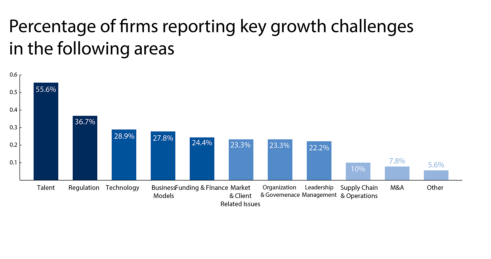The Ultimate Guide on How to Hire for Hyper-Growth Companies

Organizations in a hyper-growth stage, where the company has scaled itself to attain a compound annual growth rate of 40% or higher, have several pressing issues to manage and prioritize.
However, every other task on your to-do list is going to take a backseat once talent acquisition steps in! 55.6% of firms have reported that talent acquisition and retention is the critical growth challenge.

Source: World Economic Forum
When a business model enters the hyper-growth phase and is scaling up faster than anticipated, it becomes a priority for the organization to add several skilled resources in a comparatively short period.
Only with the right people can any business continue its ascent up the growth curb.
Keep reading to look at a few simple yet effective steps that talent acquisition teams can follow when recruiting for hyper-growth companies.
Understand Your Unique Hiring Needs
Generally, a hyper-growth company expands faster than the average growth rate of other companies in the same industry. This implies that hiring needs aren’t always planned and arise almost at the last minute.
And while all of this is true, rushing through the recruitment process will only bring more trouble your way.
Lisa Stern Haynes, global staffing lead and a senior recruiter at Google, explains in an interview how this happens.
She said, “You often see employers rushing to settle for a candidate because of time pressure, or even hiring someone due to a preexisting relationship or as a favor to someone. This can lead to a bad hire, which has a really long-lasting negative effect on a team or a company’s culture. It’s way better to take the time and go through a very robust hiring process and then identify the best possible candidate the first time around.”
Now, every recruiter experiences different hiring challenges in achieving rapid growth since the path or solution that has worked for one might not always work for another.
Therefore, assigning enough time to understand your organization’s unique requirements should be the number one consideration when hiring for hyper-growth.
1. Plan Your Timeline
In the present times, it has become increasingly common for fast-growing companies to overestimate their recruiting needs and hire too many candidates all at once. Unfortunately, too many layoffs usually follow.
As a responsible recruiter, you need to plan your hiring timeline carefully!
Say, for instance, if you estimate that you’ll need to be 500-employee strong in the coming year to keep up with the hyper-growth phase, and assuming that you’re at 300 employees right now, you’ll need to hire another 200 to get to the 500-employee mark. But that would be true only if your company sees no attrition the entire year.
Because the average employee turnover rate hovers around 10% , you can expect to lose about 30 of your employees.
This directly implies that you’ll have to plan in a way that you hire 230 (and not 200) employees to be able to maintain your company’s growth.
Furthermore, if you plan to expand your offering to capitalize on a future market trend, you might need to hire people for the engineering and sales teams before moving on to hiring for the marketing team.
On the other hand, if you want to optimize your revenue channels, you might want to prioritize recruiting marketing people before moving on to hiring for the engineering department.
One best practice here would be to formulate a simple quarter-wise hiring plan that could help you prioritize hiring needs much better.
2. Calculate and Have an Estimate of Overall Costs
Once you have decided the total number of positions you’ll be hiring for, it’s time to calculate how much cost filling each of those positions incur, or the average cost-per-hire.
This is one of the most critical metrics for making successful hiring decisions since it gives you a rough idea of how much you will be spending on average to make one hire.
As per SHRM’s Customized Talent Acquisition Benchmark Report, just about 25% of organizationsmanage to make a hire in $500 or less. Usually, cost-per-hire for the majority of companies is on the higher end, around $4,129.
This new cost per hire combined with higher attrition rates could mean that you’ll have to spend more on hiring this year. In fact, Recruiter.com expects that there will be a $50 billion increase spent on hiring in 2022.
Apart from the cost-per-hire, there are a lot of other costs associated with recruitment that you should be mindful of to avoid going overboard, especially when hiring for hyper-growth.
While internal recruitment costs usually include organizational expenses and other internal expenses such as money spent on the referral program, salaries of all members on the hiring team. External costs include every expense your company incurs outside of your internal operations, such as job board fees, costs associated with candidate background checks, agency fees, etc.
More often than not, HR leaders lack visibility into their external hiring costs, especially those assigned to hiring external workforces . Therefore, conducting a thorough cost analysis before moving ahead with mass hiring can prove highly advantageous.
3. Formulate a Structured Hiring Process
Among all other issues that result from the lack of a documented or structured recruiting process, the bad hires that it brings to your organization can hurt you the most and push you considerably behind in your hyper-growth journey.
A higher turnover rate, a longer time to hire, and a much higher cost-per-hire are some of the other issues that almost always arise due to ad hoc recruiting.
So how exactly do you formulate an effective and structured hiring process to fuel your hiring efforts at achieving hyper-growth?
Here’s a case study that will help you understand things in a better way.
One of our clients, a leading multi-state beverage producer, and distributor, was using a lot of disparate software solutions and recruitment strategies from many different locations. This led them to seek innovative recruiting solutions to assist with hiring demand during a critical period of corporate growth.
The Recruiter.com Recruiters on Demand team immediately embedded themselves within the recruitment process and developed strong relationships with the primary stakeholders and hiring managers. They quickly became an essential part of the client’s overall talent acquisition process and hiring strategy, hiring for all types of positions, including senior management roles.
Using the client’s applicant tracking system and working in tandem with the in-house recruitment personnel, the team designed and implemented a sophisticated recruitment workflow and managed the entire recruitment life-cycle, from sourcing and initial pre-screening to shepherding talented candidates through the interview process.
Having a systematic process will not only help you on the hiring front, but it will also help you build better relationships with candidates and improve their overall experience with your company.
4. Leverage Technology to Streamline Operations
Technology has become one of the most crucial drivers of recruiting and is a prerequisite for hiring for hyper-growth.
A staggering 98% of Fortune 500 businesses use recruitment software today.
In one recent article,Jonathan Singel, the global head of talent acquisition for Spotify, explains how technology has helped the audio streaming and media services giant-scale quickly.
“When recruiting in hyper-growth, investing in tech helps us to work more efficiently and effectively. For us, it forms the basis of an infrastructure that gives us time back. With that time, we focus on what only humans can do – creating that world-class experience in an increasingly competitive talent market. We never just throw tech at a challenge and expect it to be solved, but using it to streamline processes and make our pipeline more manageable, has been invaluable to us,” Singel says.
Several technology solutions are available in the market today that can help recruiters streamline their day-to-day workflows and achieve growth faster. Some of these include:
- AI-powered recruiting platforms
- Chatbot technology
- Marketing automation
- Video/mobile interviewing channels
- Jobs data analytics
- Predictive analytics
Start Hiring for Hyper-Growth Today
When deciding which tech-enabled solutions will work best for you, one best practice would be to look at your existing tech stack, hiring budget, and what your counterparts are doing and speak with experts in the tech niche. Then choose accordingly.
To know more about the kind of approach, tools, and best practices you can include within your recruiting model to achieve future growth, contact us at Recruiter.com.
We will be happy to help you build result-oriented and employee-centric workplaces in the long run.
Get the top recruiting news and insights delivered to your inbox every week. Sign up for the Recruiter Today newsletter.

